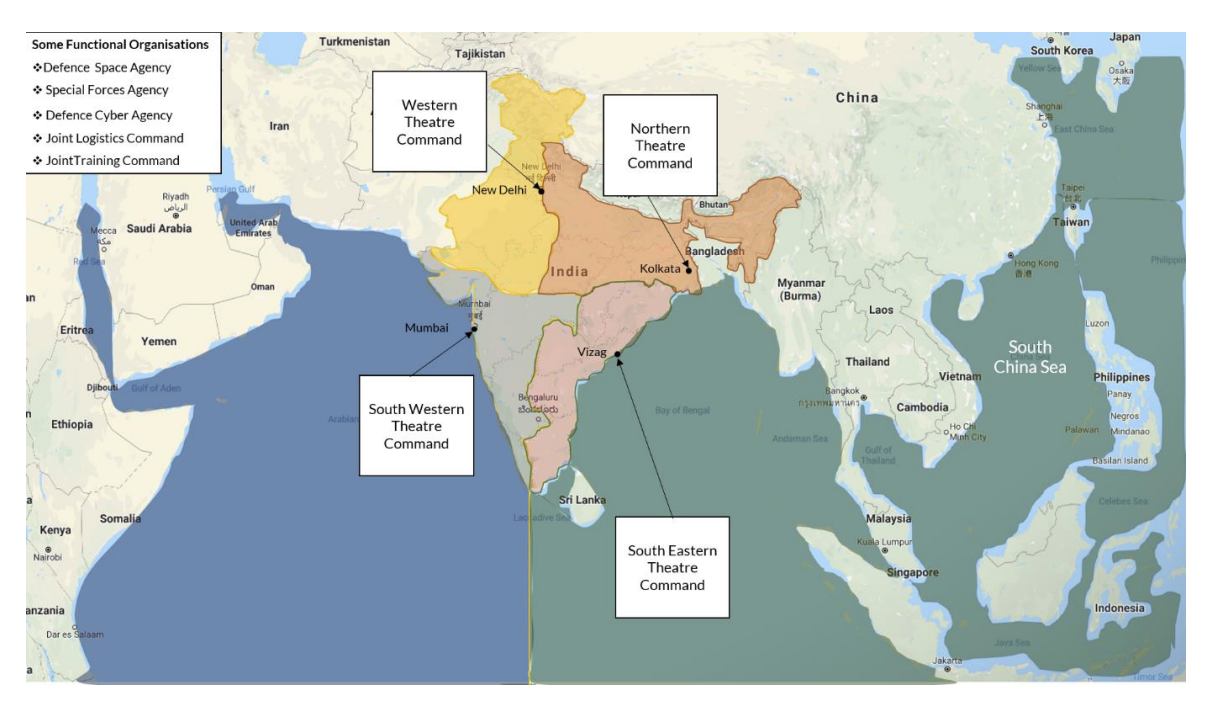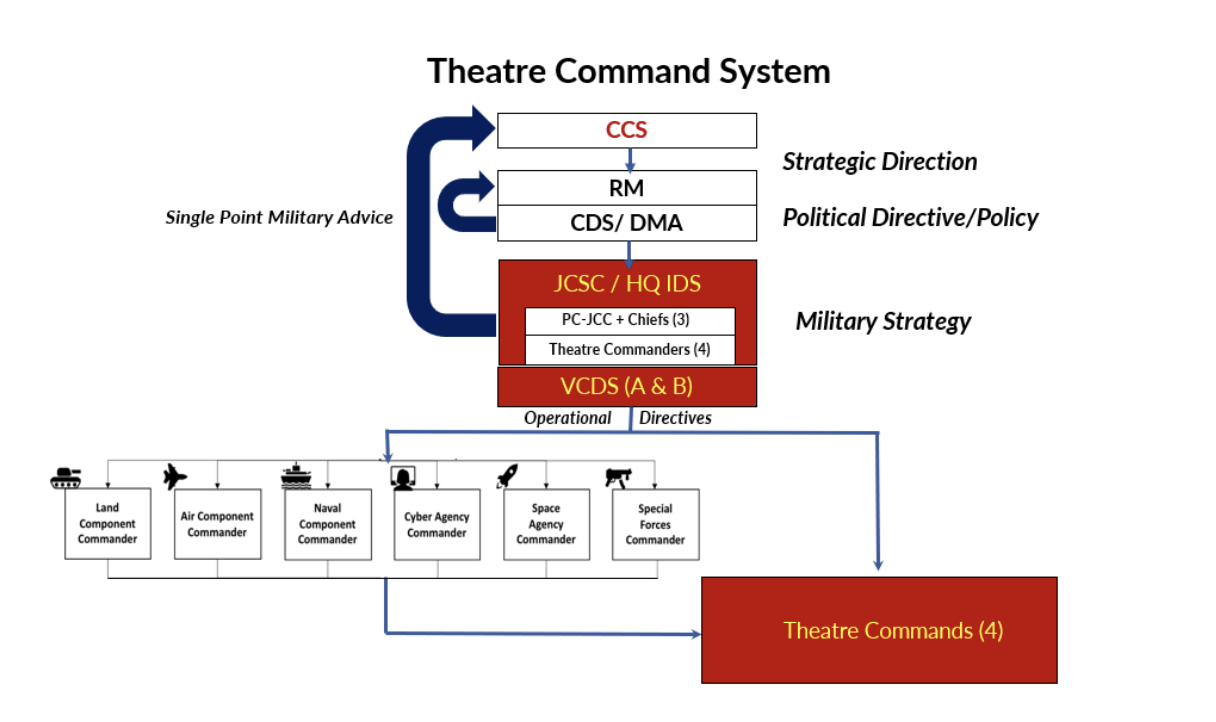Takshashila Issue Brief - Structuring Integrated Theatre Commands for India
The Parliament passed The Inter-Services Organisations (Command, Control and Discipline) Bill, 2023 (the Bill) on August 8, 2023. The Bill seeks to fix the anomaly with regard to the exercise of disciplinary and administrative powers over armed forces personnel serving in Joint-Services Organisations (JSOs) like the Andaman and Nicobar Command, Defence Space Agency or National Defence Academy. JSOs typically are staffed with personnel drawn from across the Army, Air Force, and Navy.
The Bill empowers the Commander-in-Chief or Officer-in-Command in charge of the JSO to exercise these powers, irrespective of which service the personnel belong to. However, the personnel will face disciplinary action under the respective statute governing them - Air Force Act, 1950, the Army Act, 1950, and the Navy Act, 1957 - as the case may be. The Union Government has powers under the Bill to extend the applicability of its provisions to any force.
The Bill has been touted as a precursor to the re-organisation of Indian armed forces into Integrated Theatre Commands (ITCs), a long-awaited military reform. While the Bill awaits presidential approval and as we inch closer to establishing ITCs in the country, we take this opportunity to examine the structural underpinnings of such integrated commands and offer pathways for constructing them.
Our stated position on the issue is that the theaterisation of India’s defence forces is imperative, and the debate must focus on the how, rather than the why. Based on our past research on the subject, in this issue brief, we propose the structure and the steps to be undertaken for raising ITCs.
How Should India’s Theatre Command System be Organised
In Takshashila Discussion Document India’s Theatre Command System: A Proposal, we proposed that the conceptual foundation of the ITCs be based on the notion that larger theatre structures facilitate cooperation in greater quantities of military power, and concurrent with inter-service integration, they would cater for centralised joint planning and de-centralised application. We analyse the following design issues of any proposed theatre command system: geography and threats as the basis of determining the nature and jurisdiction of integrated theatre commands, the high-level organisational structure, and the operational setup of theatre commands.
1. Demarcation of Integrated Theatre Commands (ITCs)
India faces threats on its continental borders from Pakistan and China as well as the combined Sino-Pak nexus. The maritime space of the Indo-Pacific includes the Indian Ocean as the primary domain for exercising India’s naval power, while others such as the South China Sea and Atlantic are secondary. Overall, India’s geography and the nature of threats from adversaries call for an offensive defence strategy along the land borders and a strategic offensive on the maritime front. This means that India must look to use the geographic advantage provided by peninsular India, including in defending sea lines of communications.
We propose the following division of four integrated theatre commands of India:
Indian strategic thinking must recognise that both continental and maritime strategies are interdependent and form part of a singular military operation. Moreover, given the growing threat from China, there is also a need to rebalance the deployment of forces and weaponry from the Western frontiers to the Northern and Eastern frontiers.
Therefore, the continental theatre commands can be split into two for better operational planning and execution: North (Northern Theatre Command- NTC) focussed on China and a second theatre for the West (Western Theatre Command- WTC) focussed on Pakistan. However, Ladakh and Kargil are proposed to be included in WTC due to the contiguity of terrain and common lines of communication with other territories within the WTC.
Since India’s maritime vision is one of expanding capabilities, and given the large expanse of maritime territory, the maritime theatre commands can be split into the South Western Theatre Command (SWTC) and South Eastern Theatre Command (SETC).
Considering the secondary role of internal security and the need for coordination with civil authorities and control of internal lines of communications, each Theatre will have to be assigned responsibilities based on State boundaries as shown on the map.
The operational role of the Theatre Commands will be supported by functional commands that could be integrated or be service-specific commands.
The transition to the basic Theatre Command System must be simultaneous and ensure that operational balance is maintained.
2. The Theatre Command System
The system shall consist of the following actors, other than the Cabinet Committee on Security (CCS) and the Raksha Mantri (RM) at the top followed immediately by the Chief of Defence Staff (CDS) and the Department of Military Affairs (DMA), headed by the CDS:
Joint Commanders and Staff Committee (JCSC): The existing Chiefs of Staff Committee will be renamed as the JCSC and comprise the Chairman, JCSC (CJCSC), the three services’ Chiefs and the four Theatre Commanders. The JCSC will be tasked with formulating a military strategy as per the political and policy directives received from the government. It will issue operational directives to the ITCs.
CJCSC: The CDS will function as the CJCSC, donning an operational role.
Service Chiefs: The 3 service chiefs of the Army, Air Force and Navy, will be part of the JCSC. It is important to note here that the operational responsibility falls with the Theatre Commanders, in replacement of the service chiefs.
Theatre Commanders: There will be 4 Theatre Commanders heading the respective ITCs.
VCDS (A): The present Chief of Integrated Defence Staff to the Chairman Chiefs of Staff Committee (CISC) will be renamed VCDS (A) and entrusted with the supervision of operations, staff functions, and joint training. Existing DGMO, DGNO and DG Air Ops will be subsumed under VCDS (A) as the Head of the Joint Operational Staff.
VCDS (B): The VCDS (B) will oversee the component commanders dealing with acquisition, logistics and human resource management across the forces. It will involve the integration of all common logistics to optimise procurement, inventories and repairs.
Component Commanders: There will be 6 component commanders for land, air, naval, cyber, space and special forces respectively. They will be entrusted with tasking the theatre commands with operational directives and providing resources, as may be required.
3. Structural Levels and Linkages
The JCSC consisting of the octet of the CJCSC (CDS), Service Chiefs and Theatre Commanders shall be the highest joint military decision-making body. However, the JCSC can have flexible composition based on the issue under consideration. It can involve special invitees from time to time.
4. ITCs
Each ITC will be headed by a Commander-in-Chief (C-in-C), followed by Component Commanders from each of the forces.
Northern Theatre Command (NTC): Due to the preponderance of land power, it will be headed by a C-in-C from the Army and Deputy from the Air Force. The ITBP and Assam Rifles could be brought under the control of the NTC.
Western Theatre Command (WTC): Given that the major threat from Pakistan is in the form of terrorism, which requires force application without much posturing, including through aircraft and missile strikes, the C-in-C could be from the Air Force while the Deputy should be from the Army.
South Western/ South Eastern Theatre Commands: While the C-in-Cs should be from the Navy, the Deputies can be drawn from the Army. Bringing the Coast Guard under these ITCs during confrontation/war is necessary.
This Issue Brief was compiled by Shrikrishna Upadhyaya, with inputs from Lt. Gen. Prakash Menon.
Further Resources:
Takshashila Discussion Document - India’s Theatre Command System: A Proposal by Lt. Gen. Prakash Menon
Don't wait for National Security Strategy. Bring theatre command system, first things first by Lt. Gen. Prakash Menon
CDS to DMA, Modi govt raised Indian military's hope for a theatre command. It's been 4 yrs by Lt. Gen. Prakash Menon
Why Theatre Commands must be accompanied by a Uniform Military Code by Lt. Gen. Prakash Menon
PMO can help theatre command take off by finding a politician with defence background by Lt. Gen. Prakash Menon
J&K as a separate theatre questionable. It should come under western continental command by Lt. Gen. Prakash Menon
Theatre commands to defence university, why Indian security interests need a political push by Lt. Gen. Prakash Menon
Who should call the shots in a theatre command—Air Force, Army, Navy? Let the context decide by Lt. Gen. Prakash Menon
Resolve HR issues in Navy, Army, Air Force on 3 levels. Then bring in Theatre Command System by Lt. Gen. Prakash Menon




